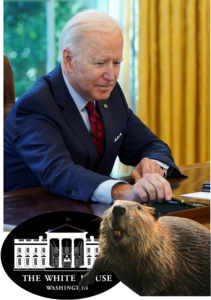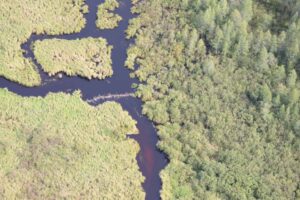Our good friend Suzanne Fouty, formerly a hydrolgist of the USFS teamed up with Bill Ripple professor of Ecology at OSU to publish this op ed. I know you’ll want to see it and pass it around.
As I See It: Protecting beavers would help with wildfire, drought challenges

Fish and wildlife are declining due to habitat loss. Major river basins, such as the Colorado and Klamath river basins, find themselves faced with water shortages and rising conflicts. Various salmon populations are facing extinction as their numbers continue to decline.
To improve conditions, we need abundant beavers building abundant beaver dams and habitat on our federally managed public lands, the source of much of our water and strongholds of biodiversity.
To get abundant beavers, dams and habitat, their survival and dispersal rates must increase. Closing these public lands to beaver trapping and hunting would do both.
Why is a closure needed? Most beaver take occurs in the winter months, when beaver pelts are at their best (a pelt brings $10 to $20). Winter is also the beaver’s breeding and pregnancy season. Entire families can be removed in a single season, suppressing population growth and future dispersal.
An excellent point. Trapping season is the very time the population is about to increase. Of course Depredation season is year-round.

The loss of beavers leaves dams unattended. As dams fail and are not repaired, ponds drain, water tables drop, habitats unravel and benefits are lost.
What type of benefits is lost? Beavers are nature’s firefighters and drought busters. Their dams, ponds and wetlands store carbon, provide valuable salmon-rearing habitat, diminish flood peaks and create high-quality wildlife habitat.
Beaver habitat can also improve water quality and help sustain summer flows, important to cities, towns, farmers and ranchers.
But these benefits require abundant wetlands and vibrant stream systems, which are currently scarce on public lands. This scarcity is due in large part to ongoing legal trapping and hunting of beaver, which continues to suppress population growth, dispersal, and beaver dam and habitat creation.
At present, the state wildlife agencies set beaver trapping and hunting seasons, with the exception of California and New Mexico, which now protect beavers. The primary focus of the state wildlife agencies is to serve trappers and hunters because these user groups contribute to agency funding through equipment purchases via the Pittman-Robertson Act and trapping and hunting licenses.
Well I wouldn’t go so far as saying California protects beavers, but I get your point.
Depending on the state, the beaver trapping/hunting season ranges from a few months to year-round. In most places, there are no limits to the number of beavers that can be killed, and reporting is minimal.
This narrow state agency management focus is limiting the productivity and biodiversity of our public lands at a time when climate changes are accelerating. We need to let our congressional representatives know that beavers must be protected on federally managed public lands so they can help restore the many thousands of miles of degraded streams that currently exist on these lands.
In the process of stream restoration, they will create numerous wetlands, resulting in major environmental and economic benefits such as natural wildfire breaks, micro reservoirs that sustain streamflows during drought and dampen flood peaks, and vastly improve fish and wildlife habitat.
Congress, and multiple rulings by the Supreme Court, have given the federal government the constitutional and statutory authority to manage fish and wildlife on federally managed public lands. Given that most state wildlife agencies refuse to protect beavers, the federal government needs to step in if we are to maximize wildfire and drought readiness on public lands.
I’m not sure that congress is more po[ular than beavers are in Oregon or anywhere else for that matter?
Protecting beavers on our federally managed public lands is a nature-based climate solution that will lead to major stream restoration and wetland creation, and bring tangible benefits to our communities. The wildfire and drought clocks are ticking down.
Let’s protect beavers on our federal public lands so they can finally swim into action for the benefit of all. Go Beavs!
Go Suzanne! You message needs to reach a lot of ears and eyes. Let’s hope this starts something good.












 Thanks to the fur of the exploited beavers, fur hats were shipped to the newly created United States of America by the millions. In Europe the demand for beaver fur was so intensive that European beavers were exterminated in Russia, with only a small population surviving in Sweden and Norway. That put the strain for raw material on the North American Beaver, which — by the mid 1800’s — was almost wiped out as well. The only thing that saved them from extinction was the difficulty of finding beaver and the evolution of the fashion and clothing industry.
Thanks to the fur of the exploited beavers, fur hats were shipped to the newly created United States of America by the millions. In Europe the demand for beaver fur was so intensive that European beavers were exterminated in Russia, with only a small population surviving in Sweden and Norway. That put the strain for raw material on the North American Beaver, which — by the mid 1800’s — was almost wiped out as well. The only thing that saved them from extinction was the difficulty of finding beaver and the evolution of the fashion and clothing industry.



































